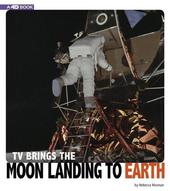
|
TV Brings the Moon Landing to Earth
Paperback / softback
Main Details
| Title |
TV Brings the Moon Landing to Earth
|
| Authors and Contributors |
By (author) Rebecca Rissman
|
| Series | Captured Television History |
|---|
| Physical Properties |
| Format:Paperback / softback | | Pages:64 | | Dimensions(mm): Height 235,Width 260 |
|
| ISBN/Barcode |
9780756560034
|
| Classifications | Dewey:629.454 |
|---|
| Audience | |
|---|
|
Publishing Details |
| Publisher |
Capstone Press
|
| Imprint |
Capstone Press
|
| Publication Date |
1 August 2019 |
| Publication Country |
United States
|
Description
On-point historical photographs combined with strong narration bring the story of the moon landing to life. Kids will learn about the cold war tensions between the US and the USSR that led to the space race and the push from presidents Kennedy and Johnson to ensure the U.S. got to the moon first. As an added bonus readers will learn about how this played out on TV. All of the networks covered it but Walter Cronkite and astronaut Wally Shirra are there to narrate how it happened with real excitement. Accompanying video will show readers what viewers saw at the time.
Author Biography
Rebecca Rissman is an award-winning children's author. She has written more than 200 books about science, history, art, and culture. Her writing has been praised by School Library Journal, Booklist, Creative Child Magazine, and Learning Magazine. She lives in Chicago, Illinois, with her husband and two daughters.
ReviewsA look at Apollo 11 through the lens of the television-viewing audience, TV Brings the Moon Landing to Earth talks about the technology that enabled Apollo video to reach Earth, the cultural context in which that video arrived, and its impacts on society. It includes plenty of detail about the operation of the mission, but is unique among Apollo 11 books I've read this year (and there have been many) for its explication of how most people on Earth would've experienced the landing in real time.-- "The Planetary Socieity" STARRED REVIEW! Television has played a significant role in modern history, and these volumes in the Captured Television History 4D series target key events shaped by television coverage. Each title sets the scene with an attention-grabbing, in-the-moment narrative of a historic event and continues with a chronological overview that gives attention to television's impact on viewers and public perception. . . .The larger size of the books allows for period photographs, sidebars, a visual time line, and other back matter. This series wraps history, technology, and media literacy into a fine package.-- "Booklist"
|